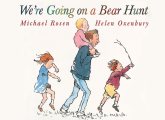Sharing musical tales is a fantastic way to embed emergent literacy skills, says Maria Kay…
Musical activities are very helpful if you want to build foundational early literacy skills. Children’s songs are repetitive, supporting the development of memory and offering practice in listening, vocalising and much more beyond. Many tell a story, too, and so introduce the concepts of cause and effect and sequencing of events, while often providing valuable information about the world. They give children the opportunity to learn new vocabulary, stimulate imagination, use their minds and bodies together, socialise and of course have a great time!
Here is a selection of tuneful tales you might like to try in your setting…
My personal favourite musical story at school was ‘Sleeping Beauty’ – with a beautiful princess, cursed by a wicked fairy godmother, sent to sleep for a hundred years and awoken by a handsome prince, it’s the story of dreams. Whether they want to be the princess, prince, wicked fairy or even the growing forest, children love re-enacting the story. With a cardboard crown adorned with ‘jewels’, a cardboard sword and a rolled-paper wand, you are ready to go. Add a circle of children and the stage is set.
Ideally, read the story beforehand so that the children can relate the story to the song. Talk about the characters and ask the children to describe them. Can they pretend to be any of them? What would it be like to live in a castle? What would you put in your castle? It’s easy to think of extension activities on this theme – homes, kings and queens, life in times gone by, well-known or local castles, wicked and good behaviour and clothes, are a few suggestions. You could build castles, hold a banquet, dress as kings and queens or learn some country dances to takes things further.
You’ll find the words to a musical retelling of Sleeping Beauty below, while the music can be found here. Ideas for actions are given in brackets. Children stand in circle with the ‘princess’ in the middle and the ‘prince’ and ‘wicked fairy’ waiting outside the circle. Children listen carefully to the introduction and then learn when to join in. As the song comes to an end, the music slows down, which enables children to learn about the concepts of start and finish – helping children to know what is happening and when reduces anxiety.
Sleeping Beauty
There was a princess long ago, long ago, long ago, (children hold hands in a circle)
There was a princess long ago, long, long ago.
The princess lived in a big high tower, (raise arms) a big high tower, a big high tower,
The princess lived in a big high tower, long, long ago.
A wicked fairy cast a spell, cast a spell, cast a spell, (enter the fairy to wave her wand and the princess falls to the floor, asleep – fairy exits to join the circle)
A wicked fairy cast a spell, long, long ago.
The princess slept for a hundred years, a hundred years, a hundred years, (everyone mimes falling asleep)
The princess slept for a hundred years, long, long ago.
A great big forest grew around, grew around, grew around, (children ‘grow’ like twisted brambles and trees until their arms are all intertwined and held aloft)
A great big forest grew around, long, long ago.
A handsome prince came galloping by, galloping by, galloping by, (prince gallops round the outside of the circle, riding his horse)
A handsome prince came galloping by, long, long ago.
He cut the trees down one by one, one by one, one by one, (prince mimes trying to break into the circle, unsuccessfully a few times – then he is allowed in)
He cut the trees down one by one, long, long ago.
He woke the princess with a kiss, with a kiss, with a kiss, (prince blows a kiss to the princess and she awakes and stands up)
He woke the princess with a kiss, long, long ago.
So everyone was happy then, happy then, happy then, (all take partners and dance)
So everyone was happy then, long, long ago. (Sing ‘long, long, ago’ slowly as the song ends.)
The tune and lyrics are repetitive and therefore easy to remember. Encourage the children to remember the sequence of events. They could make pictures to depict the story and practise putting them in order. I loved this activity when I was at primary school myself and enjoy it again today with the early years children I work with in nursery and primary schools.
Not all stories have a happy ending. I love the story of the lady who rode a crocodile down the River Nile. I’m sure you will love it too! What do you think happened to her? You can find out by listening to ‘The Crocodile Song’ here (lyrics are included on the video).
This story has lots of rhyming words that you may ask children to generate. For example, “She sailed away, on a sunny, summer’s…?” (emphasise the word you want the children to rhyme with, in this case ‘away’). You could speak the rhyme before singing it. This helps to attune children’s ears to matching sounds in language. An inflatable crocodile is a fun addition as children can take turns to ride him down the Nile. The children watching can wave him goodbye.
Children love to be mobile and enjoy events that relate to their everyday experiences. This musical story involves a bus ride – an alternative to ‘Wheels on the Bus’! You’ll find the music for ‘Bumpety Bus’ here and the words below. It has six verses, allowing six children to board the bus. If you have more children, continue singing the song until everyone has got on. Alternatively, you could give all the children numbers between one and six and anyone with the number you sing, boards the bus.
Appoint a driver to sit on the floor and ‘drive’ the bus and a conductor (a little historical) to sit behind but facing the same way, with a large space between them for the passengers to sit in. This identifies where the ‘bus’ is on the floor – i.e. between the driver and conductor.
The rest of the children must stand at imaginary ‘bus stops’ around the room. You could make bus stops with cones, for example. The children have to wait at the stop until their name or number is sung – at this point they ‘board the bus’ and sit down.
The leader sings:
We went for a ride on a bus today and who do you think we saw? ‘x-x’ (sing a child’s name). And on they got (child ‘boards’ the bus) and off we went, bumpety, bumpety, bumpety, bump, and who do you think we saw? ‘x-x’ (next child’s name – then they board the bus). And on they got and off we went, etc.
This continues until all the children have boarded the bus. To signify that the song is coming to an end, slow down and sing the last verse as:
And on she got and off we went, bumpety, bumpety, bumpety, bumpety, BUMP!
This activity also helps children to think about the patience required when waiting and to listen for their names – and, of course, they’ll enjoy bumping up and down on the bus. It can lead to discussion about where the bus might go and the people at the bus stop – e.g. are they wrapped up against the cold or relaxed in the sun?
You can use songs to help children to learn about life cycles as well as a myriad of other life experiences. You’ll find the music and lyrics to ‘Creepy Crawly Caterpillar’ here. It’s sung to the tune of ‘Incy Wincy Spider’ and explains how a caterpillar becomes a butterfly. If you have a soft toy that turns from one to the other, this provides the perfect accompaniment – otherwise use actions to depict the caterpillar and the butterfly.
An alternative to hand actions would be for children to ‘be’ the caterpillar wriggling on the floor, shedding their skin, forming a chrysalis (curling into a ball) and then becoming a butterfly and flying around with outstretched wings.
Gesturing is a valuable form of communication that helps to support early speech. Sign language, an extended form, is good exercise for the brain, as it uses mind and body. Singing and signing together necessitates the use of both hemispheres of the brain, ensuring the connections between the two are used. Our brains produce far too many connections from birth and these gradually die away as we strengthen the ones we need and lose those we don’t need. Using both sides of the brain ensures that these connections are kept working.
A fun song that can be used in a variety of ways is ‘My Hat It Has Three Corners’. It’s easy to learn as it’s very repetitive but can be made increasingly challenging by adding sign language, clapping the syllables instead of speaking particular words (for example, clap once instead of singing ‘hat’ each time and then ‘corners’ (two claps), and then clap for both ‘hat’ and ‘corners’) or singing it in different languages. You can find videos of this song in Spanish here and in sign language here. Here are the words in English:
My hat it has three corners,
Three corners has my hat.
If it did not have three corners,
It would not be my hat.
For anyone who has not yet discovered the wonderful world of Raffi, he has wonderful songs for children. My particular favourite, which helps children to listen for and to generate their own rhymes, is ‘Down by the Bay’, and you can find a performance of it here. You can see the concentration, anticipation and thrill on the faces of the children in his audience. Raffi plays with the words encouraging the children to find matching rhymes.
The ability to detect sound patterns in words and to discriminate between sounds is vitally important for literacy. It is a skill that can easily be promoted through music in the early years. However, simply singing songs and reciting rhymes is not enough for this to happen automatically; children’s attention must be drawn to the rhyming sounds, syllables or initial letter sounds.
Maria is the author of Sound Before Symbol: Developing Literacy through Music and Alphabet Book + More: A Sounds and Symbols ‘literacy through music’ book. To find out more, visit bryantandkaypublishing.co.uk
Maria’s Sounds and Symbols Literacy through Music Resource Pack (£489) is available now. It is a comprehensive, research-based and informative resource, full of engaging activities and is perfect for building foundational literacy skills in the early years (0–8 years). Email .(JavaScript must be enabled to view this email address) to order your pack.

Going on a Bear Hunt activities – Easy preschool ideas
Editors picks

Body autonomy – empowering children to say ‘no’
Editors picks
